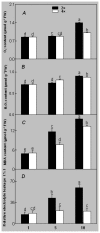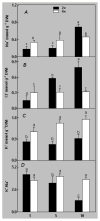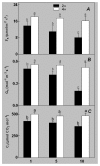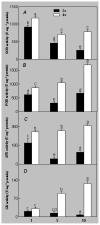Physiological and proteomic responses of diploid and tetraploid black locust (Robinia pseudoacacia L.) subjected to salt stress
- PMID: 24129170
- PMCID: PMC3821616
- DOI: 10.3390/ijms141020299
Physiological and proteomic responses of diploid and tetraploid black locust (Robinia pseudoacacia L.) subjected to salt stress
Abstract
Tetraploid black locust (Robinia pseudoacacia L.) is adaptable to salt stress. Here, we compared morphological, physiological, ultrastructural, and proteomic traits of leaves in tetraploid black locust and its diploid relatives under salt stress. The results showed that diploid (2×) plants suffered from greater negative effects than those of tetraploid (4×) plants. After salt treatment, plant growth was inhibited, photosynthesis was reduced, reactive oxygen species, malondialdehyde content, and relative electrolyte leakage increased, and defense-related enzyme activities decreased in 2× compared to those in 4×. In addition, salt stress resulted in distorted chloroplasts, swollen thylakoid membranes, accumulation of plastoglobules, and increased starch grains in 2× compared to those in 4×. However, 4× developed diverse responses under salt stress. A comparative proteomic analysis revealed that 41 and 37 proteins were differentially expressed in 2× and 4×, respectively. These proteins were mainly involved in photosynthesis, stress and defense, energy, metabolism, transcription/translation, and transportation. Distinct patterns of protein changes between 2× and 4× were analyzed. Collectively, our results suggest that the plants showed significantly different responses to salt stress based on ploidy level of the plant. The 4× possessed a better salt protection mechanism than that of 2×, suggesting salt tolerance in the polyploid plant.
Figures












Similar articles
-
Physiological and proteomic responses to salt stress in chloroplasts of diploid and tetraploid black locust (Robinia pseudoacacia L.).Sci Rep. 2016 Mar 15;6:23098. doi: 10.1038/srep23098. Sci Rep. 2016. PMID: 26975701 Free PMC article.
-
Comparative mitochondrial proteomic, physiological, biochemical and ultrastructural profiling reveal factors underpinning salt tolerance in tetraploid black locust (Robinia pseudoacacia L.).BMC Genomics. 2017 Aug 22;18(1):648. doi: 10.1186/s12864-017-4038-2. BMC Genomics. 2017. PMID: 28830360 Free PMC article.
-
Physiological and Proteomic Responses of the Tetraploid Robinia pseudoacacia L. to High CO2 Levels.Int J Mol Sci. 2024 May 11;25(10):5262. doi: 10.3390/ijms25105262. Int J Mol Sci. 2024. PMID: 38791300 Free PMC article.
-
The effects of elevated CO2 (0.5%) on chloroplasts in the tetraploid black locust (Robinia pseudoacacia L.).Ecol Evol. 2017 Nov 1;7(24):10546-10555. doi: 10.1002/ece3.3545. eCollection 2017 Dec. Ecol Evol. 2017. PMID: 29299236 Free PMC article.
-
Better salinity tolerance in tetraploid vs diploid volkamer lemon seedlings is associated with robust antioxidant and osmotic adjustment mechanisms.J Plant Physiol. 2020 Jan;244:153071. doi: 10.1016/j.jplph.2019.153071. Epub 2019 Nov 4. J Plant Physiol. 2020. PMID: 31756571
Cited by
-
Comparative transcriptome study of switchgrass (Panicum virgatum L.) homologous autopolyploid and its parental amphidiploid responding to consistent drought stress.Biotechnol Biofuels. 2020 Oct 15;13:170. doi: 10.1186/s13068-020-01810-z. eCollection 2020. Biotechnol Biofuels. 2020. PMID: 33072185 Free PMC article.
-
Multiple responses contribute to the enhanced drought tolerance of the autotetraploid Ziziphus jujuba Mill. var. spinosa.Cell Biosci. 2021 Jun 30;11(1):119. doi: 10.1186/s13578-021-00633-1. Cell Biosci. 2021. PMID: 34193297 Free PMC article.
-
Accession-specific parent-of-origin dependent and independent genome dosage effects on salt tolerance in Arabidopsis thaliana.R Soc Open Sci. 2024 May 8;11(5):231766. doi: 10.1098/rsos.231766. eCollection 2024 May. R Soc Open Sci. 2024. PMID: 38721127 Free PMC article.
-
Contrasting photosynthesis and photoinhibition in tetraploid and its autodiploid honeysuckle (Lonicera japonica Thunb.) under salt stress.Front Plant Sci. 2015 Apr 9;6:227. doi: 10.3389/fpls.2015.00227. eCollection 2015. Front Plant Sci. 2015. PMID: 25914706 Free PMC article.
-
Comparative transcriptome analysis reveals synergistic and disparate defense pathways in the leaves and roots of trifoliate orange (Poncirus trifoliata) autotetraploids with enhanced salt tolerance.Hortic Res. 2020 Jun 1;7(1):88. doi: 10.1038/s41438-020-0311-7. eCollection 2020. Hortic Res. 2020. PMID: 32528700 Free PMC article.
References
Publication types
MeSH terms
Substances
LinkOut - more resources
Full Text Sources
Other Literature Sources

